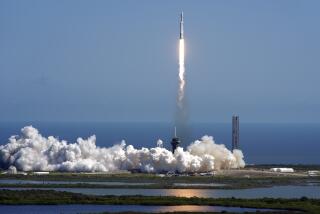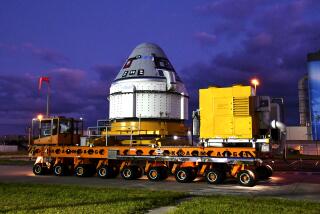Craft Readied for Launching on Saturn Trip
- Share via
CAPE CANAVERAL, Fla. — NASA made final preparations Saturday for the launch of a controversial nuclear-powered probe to Saturn.
The Cassini spacecraft was set to embark on a nearly seven-year voyage to the ringed planet at 1:55 a.m. PDT Monday, aboard a powerful Air Force Titan 4B rocket.
As launch pad workers readied the 183-foot booster for blastoff, a small group of anti-nuclear protesters held a vigil outside Cape Canaveral Air Station.
The activists, led by the Florida Coalition for Peace and Justice, say the National Aeronautics and Space Administration is putting lives at risk.
NASA and the Department of Energy, which built the probe’s three nuclear batteries, say extensive testing of the devices has proved the chances of a radioactive release are minimal.
“We’ve put them through explosions, we’ve put them through impacts, we’ve put them next to solid rocket fuel and burned them, we’ve done over pressure tests,” said Beverly Cook of the Department of Energy.
The probe’s power sources generate electricity from heat produced by the natural decay of plutonium dioxide. NASA stresses that they are not nuclear reactors. The generators contain 72 pounds of plutonium.
Cassini’s opponents say nobody really knows what the dangers are. Among the most vocal critics is Michio Kaku, a professor of theoretical physics at City University of New York.
“I find that the NASA bureaucrats in some sense are living in fantasyland. Pure guesswork has replaced rigorous physics.”
Cassini carries a European-built probe called Huygens that will parachute to the surface of Saturn’s largest moon, Titan, where scientists suspect oceans of liquid methane will be found.
The $3.4-billion mission is the last of NASA’s big-budget planetary explorers. Cassini is due to arrive at Saturn in July 2004.
More to Read
Sign up for Essential California
The most important California stories and recommendations in your inbox every morning.
You may occasionally receive promotional content from the Los Angeles Times.










